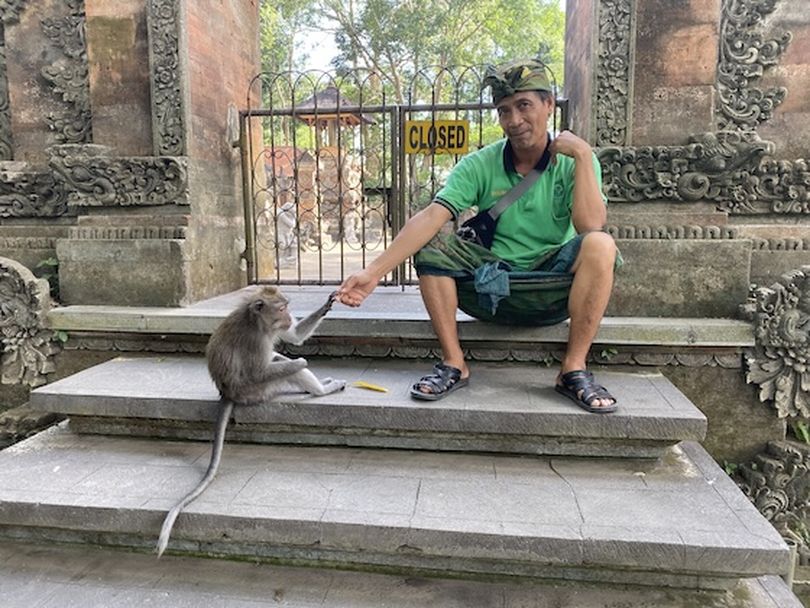Bali’s allure is its connection to nature

When anyone mentions the Indonesian island of Bali, a number of different images come up. And all of them involve beauty.
To state anything to the contrary would a lie. Because Bali truly is a natural wonder, with wide sandy beaches, waves that surfers from all over the world come to enjoy, majestic ocean-side cliffs, rain forests and mountain retreats.
It’s just that all of that is only part of what Bali has to offer. For when you arrive at I Gusti Ngurah Rai International Airport, which we did in December 2019, the first experience you have is a whole other sense of the island – and it isn’t particularly complimentary.
We’d flown there from Indonesia’s capital, Jakarta. My wife, Mary Pat Treuthart, had just presented at a conference in the city of Bandung, and we wanted to spend the last few days far from the crowds. Indonesia has a total population of some 273 million people, making it the fourth-largest country in the world.
Some half of the population lives on the main island of Java, making city life there a challenge – especially for anyone simply trying to cross the street.
I for one never imagined how this crush of people might affect Bali. But as we found out, the island itself has a population of 4.4 million (2022 figures), which is crammed into a mere 2,230 square miles. Compare that to the big island of Hawaii, which in 2020 had only 200,629 people sharing some 4,028 square miles.
And that crush of people hits you almost immediately, right after you pass by the welcoming sign that declares, “Welcome to Bali, The Last Paradise in the World,” and head out into the area between the airport and Bali’s capital city of Denpasar.
We’d arranged for a driver to meet us and take us to our first stop, the village of Ubud, which Lonely planet describes as “a place where traditional Balinese culture imbues every waking moment, colorful offerings adorn the streets, and the hypnotic strains of gamelan are an ever-present soundtrack to everyday life.”
(Incidentally, yeah, I had to look up the term “gamelan” and found this: “Gamelan refers to the traditional Indonesian percussion orchestra and to the set of musical instruments used. Consisting primarily of ornate, percussive instruments made of hand-forged metal, the ensemble typically includes xylophones, gongs, gong-chimes, drums, cymbals, string instruments and bamboo flutes.”)
To be honest, I don’t recall hearing any such music. What I did hear, maybe for the first full hour, was the grating sound of traffic as our driver weaved his way through the rush of cars, motorcycles, trucks and the occasional horse-drawn cart. I remember passing by house after house, all of which fronted the gradually narrowing road so closely as to make me worry that we’d hit someone.
This, I thought, is not my idea of paradise.
But, thankfully, it didn’t last. We finally broke out of the countryside and soon found ourselves in the town of Ubud. Mary Pat had booked a room at the Barong Resort & Spa, and our accommodations were ultra-comfortable, centrally located and gave us access both to a pool and a restaurant.
The comfort factor was particularly fortunate because Mary Pat soon came down with an ailment that confined her to bed. That left me on my own to walk around and explore, which is how I came to see, among other sites, the Ubud Palace, the Agung Rai Museum of Art and – my favorite – the Sacred Monkey Forest Sanctuary.
I explored pretty much all of the sanctuary’s 30-plus acres, and I saw a number of the Balinese long-tailed monkeys (or Macaques) that live there – the total population of which, so the sanctuary reports, amounts to some 1,200 split into 10 different groups.
Dating back to the 14th century, the site of the sanctuary is considered sacred. It houses three different temples, and at least 115 different species of trees have been identified on the grounds. But the main draw, at least among tourists, is the macaques.
As the sanctuary’s official website states, “The monkeys, seen as sacred animals, symbolize both protection and mischief, fostering a unique connection between humans and wildlife.” It also warns visitors not to consider them as pets: They can bite. I made sure not to get too close.
Since our stay in Bali was limited, we weren’t able to see many of the sites in the central and northwest parts of the island that the tourist guides suggest. But we did visit the beach town of Canggu, which boasts some of the best sunsets I’ve ever experienced (which I wrote about in a previous post). And we drank beers at Old Man’s, the town’s iconic bar that sits adjacent to Batu Bolong Beach, a popular surfing spot.
We also visited the Tanah Lot Temple, an ancient Hindu temple that sits on a rock, or island if you prefer, that was renovated in 1980 by a loan from the Japanese government. I was surprised to read the Wikipedia entry, which states, “(O)ver one-third of Tanah Lot's ‘rock’ is actually cleverly disguised artificial rock created during the Japanese-funded and supervised renovation and stabilization program.”
And just before we left, we attended one of the nightly Kecak & Fire Dance shows at the Uluwatu Temple. As impressive as anything Las Vegas has to offer, the outdoor show tells a story based on the Sanskrit epic the Ramayana.
That final night, sitting in the stands under an open sky amid a thousand or more other customers, was a special treat. Down below we could see the dancers, some of whom were wielding fiery torches like drum-major batons. And meanwhile, to our left, the sun was setting over the Indian Ocean.
By that time, Bali had indeed proved to us that it deserves to be labeled a “paradise.”
You just have to get away from the crush of people to find it.
